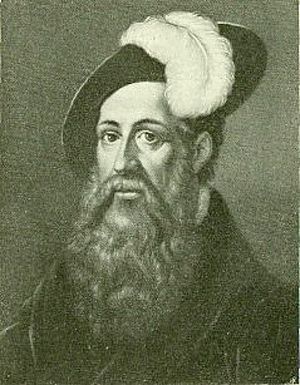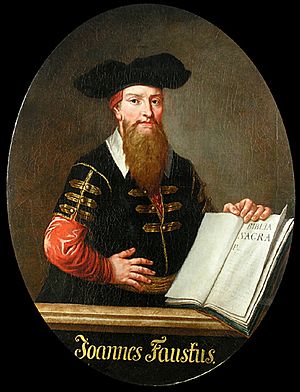Johann Fust facts for kids
Johann Fust (born around 1400, died October 30, 1466) was an important early German printer. He played a big part in the history of printing, especially with the famous Gutenberg Bible.
Contents
Fust's Family History
Johann Fust was born into a well-known family in Mainz, Germany. His family had been important citizens, called burghers, since the 1200s. Many of his relatives held important jobs in the city government and in the church.
His family's name was spelled "Fust" for a long time. But in 1506, his son-in-law, Peter Schöffer, started calling him "Faust." After that, the family often used the name Faust. Johann's brother, Jacob, was a goldsmith. He was also a mayor in 1462 when Mainz was attacked. It seems Jacob might have died during this attack.
Working with Gutenberg
Fust was a goldsmith and also worked as a financier, meaning he loaned money. He is often linked to Johann Gutenberg, who is famous for inventing the printing press. Some people think Fust helped Gutenberg a lot, giving him money to develop his invention. Others believe Fust took advantage of Gutenberg and stole his ideas.
We know from a document from November 6, 1455, that Fust loaned money to Gutenberg. He gave Gutenberg 800 guilders in 1450 and another 800 in 1452. This money was for Gutenberg to continue his printing work. However, in 1455, Fust sued Gutenberg to get his money back. He claimed Gutenberg owed him 2026 guilders, including interest. Gutenberg said Fust had not paid the 300 guilders a year he promised for costs and wages. Gutenberg also said Fust had agreed not to charge interest.
The court case happened on November 6, 1455, in Mainz. The court decided in Fust's favor. Fust swore that he had borrowed 1550 guilders himself to give to Gutenberg.
Fust and Schöffer's Printing Business
After the lawsuit, Johann Fust started a new printing business with Peter Schöffer. Peter Schöffer had worked as an apprentice for Gutenberg. He also married Fust's only daughter, Christina, around 1455.
Fust and Schöffer's first major book was the Psalter. It was printed on August 14, 1457. This was a very important book because it was the first printed book with a complete date. It was also known for its beautiful large letters printed in two colors, red and blue. They printed new versions of the Psalter in 1459, 1490, 1502, and 1516.
Other important books printed by Fust and Schöffer include:
- Guillaume Durand, Rationale divinorum officiorum (1459)
- The Clementine Constitutions (1460)
- The Biblia Sacra Latina (Latin Bible) (1462), which was a large two-volume book.
- The Sixth Book of Decretals (1465)
- Cicero. De officiis (1465)
Fust as a Smart Businessman
Johann Fust was more of a businessman and salesman than a printer himself. He loaned Gutenberg money to start his printing project. Fust felt that since he had invested so much, he should be a partner in the project.
When only three Bibles were left to be finished, Fust decided to demand his loans back. On November 6, 1455, he asked Gutenberg for 2,026 guilders. He even said in court that he had to borrow the money he gave Gutenberg at 6% interest. In the end, Gutenberg had to pay Fust 1,200 guilders. He also lost all the completed Bibles, unfinished books, and his workshop to Fust.
After this, Gutenberg was rarely heard from again. Fust then partnered with Peter Schöffer. Schöffer had learned all the printing skills from Gutenberg. This meant Schöffer could use those techniques, while Fust could focus on selling the books.
They printed copies of the famous "42-line Bible" on both paper and vellum (a type of parchment). The paper Bibles sold for 40 guilders each, and the vellum ones sold for 75 guilders. Fust even opened a sales office in Paris. This helped spread the Bible's sales to other countries, which was very new for that time.
Witchcraft Stories
At one point, some people believed Johann Fust was working with the devil. This happened after he sold several of Gutenberg's Bibles to King Louis XI of France. People thought Fust was using witchcraft.
This idea came about for a few reasons. Some of the letters in the Bibles were printed in red ink, which people mistakenly thought was blood. Also, the King and his assistants believed these Bibles were copied by hand. But they noticed that all the letters were exactly the same, which was very strange for hand-copied books.
Fust had sold 50 Bibles in Paris. People there could not understand how so many Bibles could be made and sold so quickly. Printing was not yet well known in France. Parisians thought the devil must have helped make these copies. Fust was even put in jail for a short time on charges of black magic. He was eventually released when it was proven that he was running a business. Printing allowed him to make many copies of the same text very quickly.
Historians believe that Fust might have worried some people in the Paris book trade. His Bibles might have even been taken away in Paris in 1465. But generally, the church and universities welcomed the new printing technology.
Johann Fust's Death
Johann Fust is believed to have traveled to Paris in 1466. He may have died there from the plague, which was widespread in August and September of that year. We know he was in Paris on July 4, 1466. On that day, he gave a copy of his second edition of Cicero to Louis de Lavernade. This is known from a note written by Lavernade in the book itself.
Fust was buried in the abbey-church of St. Victor in Paris. On October 30, around 1471, Peter Schöffer and Fust's son, Johann Fust Jr., started a yearly church service to remember him there. Peter Schöffer also started a similar service for Fust in 1473 in Mainz.
Some people believe that the speed and perfect copies made by the printing press led French officials to think Fust was a magician. This might be why some historians connect Fust with the legendary character of Faust.
Lasting Influence
After Peter Schöffer married Fust’s daughter, Christina, the printing business continued through their children. Fust and Schöffer tried to keep their printing methods secret. They even made their workers promise not to tell anyone. However, the secrets eventually became known.
Schöffer’s sons, Johann and Peter (who were Fust’s grandsons), continued the family printing business. The younger Peter’s son, Ivo, also became a printer. Johann Fust may not have started as a printer, but he certainly helped shape a whole new generation of printing. What began in Germany soon spread to other parts of the world.
Many people still give Johann Gutenberg credit for the success of the 42-line Bible and for printing in general. However, it is true that without Johann Fust, this Bible might never have been created. Fust also managed the sales and brought this new invention to people in other countries. Thanks to Fust’s partnership with Schöffer, a whole new era of printing began. While some might see Fust's actions as greedy, others see them as smart business choices that helped printing grow.
See also
 In Spanish: Johann Fust para niños
In Spanish: Johann Fust para niños



